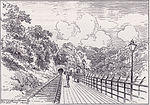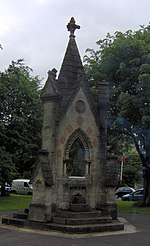Leigh Woods National Nature Reserve

Leigh Woods is a 2-square-kilometre (0.77 sq mi) area of woodland on the south-west side of the Avon Gorge, close to the Clifton Suspension Bridge, within North Somerset opposite the English city of Bristol and north of the Ashton Court estate, of which it formed a part. Stokeleigh Camp, a hillfort thought to have been occupied from the third century BC to the first century AD and possibly also in the Middle Ages, lies within the reserve on the edge of the Nightingale Valley. On the bank of the Avon, within the reserve, are quarries for limestone and celestine which were worked in the 18th and 19th centuries are now derelict. In 1909 part of the woodland was donated to the National Trust by George Alfred Wills, to prevent development of the city beside the gorge following the building of the Leigh Woods suburb. Areas not owned by the National Trust have since been taken over by Forestry England. Rare trees include multiple species of Sorbus with at least nine native and four imported species. Bristol rockcress (Arabis scabra) which is unique to the Avon Gorge can be seen flowering in April; various species of orchids and western spiked speedwell (Veronica spicata) are common in June and July. It is a national nature reserve and is included in the Avon Gorge Site of Special Scientific Interest.
Excerpt from the Wikipedia article Leigh Woods National Nature Reserve (License: CC BY-SA 3.0, Authors, Images).Leigh Woods National Nature Reserve
Stoke Park Road, Bristol Stoke Bishop
Geographical coordinates (GPS) Address External links Nearby Places Show on map
Geographical coordinates (GPS)
| Latitude | Longitude |
|---|---|
| N 51.4631 ° | E -2.6392 ° |
Address
Leigh Woods
Stoke Park Road
BS9 1JE Bristol, Stoke Bishop
England, United Kingdom
Open on Google Maps









